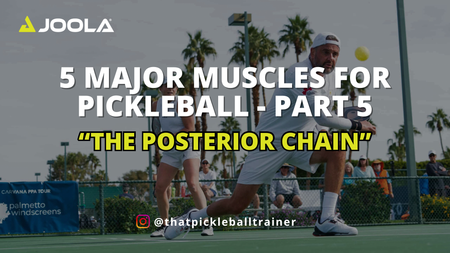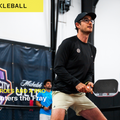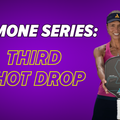
The Crucial Role of a Strong Posterior Chain in Pickleball
In the fast-paced world of pickleball, success hinges not only on quick reflexes and precise shots but also on the strength of a player's posterior chain. The posterior chain, a network of muscles running along the back of the body, plays a pivotal role in executing powerful serves, swift lateral movements, and maintaining overall stability. In this educational piece, we dive into the importance of cultivating a robust posterior chain for mastering the game of pickleball.
Understanding the Posterior Chain:
Before we dive into the specifics, let's understand what comprises the posterior chain. The posterior chain includes the muscles along the backside of the body, from the calves and hamstrings to the glutes and the muscles along the spine. It serves as a powerhouse for various movements, making it a focal point for any athlete, especially in a dynamic sport like pickleball. Take JOOLA pro, Dekel Bar, for example. Due to a strong posterior chain, Dekel is able to explode through his serve and drives as well as move swiftly around the court.

The Significance of Hamstring Training:
Why hamstrings matter in pickleball - as a pickleball player, the explosive movements and sudden bursts of speed demand strong and flexible hamstrings. When playing pickleball you are loading your posterior chain the entire time because you are constantly hinging at the hips. Engaging in targeted hamstring training not only aids in injury prevention but also enhances your endurance and the ability to execute quick and powerful movements on the court.
Incorporate Eccentric Training:
Eccentric training, which focuses on lengthening muscles under tension, is particularly beneficial for hamstrings. Controlled eccentric movements during exercises like Romanian deadlifts and hamstring curls contribute to improved muscle strength and resilience. This, in turn, can be a game-changer in preventing injuries like strains and pulls during intense pickleball sessions.
The Role of Hinging in Pickleball:
Pickleball relies heavily on the ability to hinge efficiently. Whether you are getting settled at the kitchen or maneuvering to return a shot, the proper execution of the hinging movement is integral. Strengthening this movement pattern through exercises like kettlebell swings and hip thrusts enhances your on-court performance.
Understanding the Gluteus Medius:
While the larger glute muscles often steal the spotlight, the glute medius, a smaller muscle on the side of the hip, plays a crucial role in stabilizing the pelvis and supporting lateral movements.
The Impact of a Strong Gluteus Medius in Pickleball:
A strong glute medius contributes to improved balance and lateral stability, essential for quick direction changes on the pickleball court. Incorporating exercises like lateral leg raises and clamshells into your training regimen can specifically target and strengthen this often-overlooked muscle. While these exercises can be great, performing relatively heavy deadlifts, squats, and lunges are the best ways to strengthen your glutes.
Posterior Chain Training Routine - Dynamic Stretching:
Before engaging in pickleball or any intense physical activity, a dynamic warm-up that includes dynamic hamstring stretches is crucial. Leg swings, high knees, and walking lunges with a hamstring stretch are effective ways to prepare your hamstrings for the demands of the game.
Strengthening with Eccentric Exercises:
Incorporate eccentric hamstring exercises such as Nordic hamstring curls and stability ball leg curls into your training routine. These exercises not only enhance strength but also fortify the hamstrings against potential injuries. These are exercises all of our athletes are doing in a certain capacity all year long.
Mastering the Hip Hinge:
Devote time to perfecting your hip hinge technique. This involves maintaining a straight back while bending at the hips, ensuring that the movement originates from the hip joint rather than the spine or the knee. Practice this movement pattern with bodyweight exercises like hip hinges and progress to weighted exercises as your strength increases.
Powerful Hinging Exercises:
Include compound exercises like deadlifts and kettlebell swings in your training routine. These movements mimic the hinging action required in pickleball, strengthening the posterior chain and improving your overall performance on the court.
Frequently Asked Questions (FAQs):
Q1: CAN A STRONG POSTERIOR CHAIN IMPROVE MY PICKLEBALL SERVE?
Answer: Absolutely. A strong posterior chain provides the power and stability needed for forceful hip extension which can help your serve.
Q2: HOW OFTEN SHOULD I INCLUDE POSTERIOR CHAIN TRAINING IN MY ROUTINE?
Answer: Aim for at least two to three sessions per week, focusing on a well-rounded mix of hamstring, hinging, and glute medius exercises.
Q3: CAN STRENGTHENING THE GLUTEUS MEDIUS PREVENT KNEE PAIN IN PICKLEBALL PLAYERS?
Answer: Yes. A strong glute medius contributes to better pelvic stability, reducing the risk of knee pain and injuries during pickleball movements.
Conclusion: Elevate Your Pickleball With a Strong Posterior Chain
In the realm of pickleball, where agility, power, and stability are paramount, cultivating a robust posterior chain is non-negotiable. From hamstring training to perfecting the hinging technique and activating the gluteus medius, every aspect of posterior chain strength contributes to a masterful performance on the court. Incorporate these principles into your training regimen, and watch as your pickleball game reaches new heights.
For more tips on elevating your pickleball game through fitness and recovery, check out C2performance.




